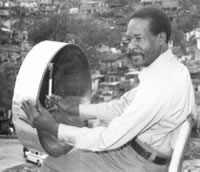The History of the Steelpan

The Steelpan or pan, invented circa 1935 in the Republic of Trinidad and Tobago's National Musical Instrument. It is a definite-pitch, acoustic percussion instrument made of steel, with a playing surface of circular cross section. This is stretched to a concave shape and attached to a hollow, cylindrical resonator called a skirt. The playing surface is divided into a number of isolated convex sections called notes.
A steelpan is usually played with sticks: handheld, rubber-tipped, non-sonorous mallets. Those skilled in playing the instrument are called pannists. An ensemble of steelpans encompassing approximately six chromatic octaves is known as a steel band or steel orchestra. The musical tempo is regulated by a rhythm section of musicians playing traditional percussion instruments, collectively called the engine room.
Further Reading
Winston Simon on WikiSteelpans on Wiki




